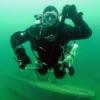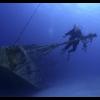No. V-Planner says you need about 180 cf. Rule of thirds takes you to 270 cf. Any deco dive is considered an overhead dive, and if you are spending 45 minutes on a wreck then you may be doing penetration. That is two overhead factors. Are you saying you would not use thirds? What rule are you using for contingencies? Even without the contingency gas you aren't going to do this on the 150 cf you have in AL80s.
You also seem to be thinking that a NE wreck dive is like a FL reef dive. It isn't. Stuff happens.
Whether you use air or some other mix doesn't change your SAC rate. You're going to need 180 cf of something, plus deco gas. I used Nitrox 50 for the deco gas in this calculation, and I am not counting 38.5 cf of that. I am just looking at the back gas.
Yes, any deco dive is considered an overhead dive. I spend half my time right now doing overhead dives. However, with no swimming exit to contend with, I am MORE than comfortable diving on halfs. If I am doing cave, I will be diving thirds plus rockbottom. Ocean diving, is halves plus rockbottom for my comfort. The idea of thirds was to deal with a swimming exit. Again, I ask what agency is teaching rule of thirds for open ocean dives? If you are doing a wreck penetration, I'd certainly use thirds. Actually, I'd use thirds plus a reserve. And yes, I'd certaly be looking at large tanks.
What makes you think I believe NE Wreck diving is like FL Reef diving? Heck, I've never seen a reef. I have seen some wrecks though. And a number of caverns.
This has probably veered far enough away from lift capacity.
I'll summarize my thoughts:
1. Try to dive with a balanced setup. Meaning that should you lose your primary buoyancy, you won't be in a horribly negative scenario.
2. That means you are going to have to either dive with tanks that make you neutral, carry backup buoyancy, or use a weightbelt. Or some combination of the above.
3. In my estimation, if you are doing technical diving, you should be willing to purchase the right tool for the job at hand. If the dive calls for you carry 300cuft of gas, then don't dive AL80s and a bunch of stages. If the dive calls for 100cuft of gas, don't carry twin 121s.
4. It's interesting that it breaks down nicely. For longer and deeper dives, you are going to get cold if you don't wear better exposure protection. This requires more weight, and thus larger tanks. Which keeps you balanced. Short and shallow dives often don't need heavy exposure gear nor do they require heavy tanks. So again, the rig stays balanced. For the work I am doing 75-120ft in warm water, my AL80s are lovely. I will add a set of 108s for cave work, and a set of 130s for longer cave work or deeper ocean work. I will avoid 104s simply because they are heavier than anything I forsee needing unless I start taking regular trips to the great lakes.
5. In none of these cases I've mentioned, can I see needing more than 60# of lift, and in most cases, probably half that. The gas swing on a set of 130s is probably 12 pounds, less with helium. If the rig is balanced, that should be all you have to lift with your BC. If you have to deal with a flooded suit, or a buddy's failure, you'd have PLENTY of reserve left with a 45# lift wing.
6. I find it somewhat scary when I hear drysuit divers saying they need 30+ pounds of lead. To me, that indicates they are using the wrong BC, or the wrong tanks or both. I'm talking doubles divers here, not single tank divers. If the diver found themselves in a position to have to drop the belt, there is simply no way they could control the ascent. I'd really not want more than 10 pounds on a weightbelt under most circumstances.
Thank you all, this discussion has been very helpful in understanding many things.

















